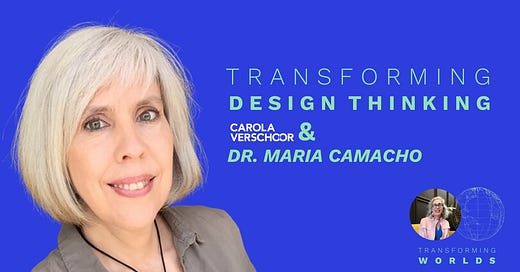Transforming Design Thinking: a conversation with Dr. Maria Camacho
🌍🤝 How might we unlock the transformative potential of design thinking? Through human-centeredness, creativity, and systems thinking: it can help designers and non-designers transform our world!
TL;DR:
In an engaging conversation with Dr. Maria Camacho, we explored the evolution and relevance of design thinking. An approach that transcends traditional design, emphasizing creation, human-centeredness, and systems thinking. Through its extended use, it has transformed into what Dr. Camacho calls contemporary design thinking. It has become enriched and is available to everyone, offering a hopeful vision for a more collaborative and transformational future.
In the latest episode of the Transforming Worlds 🐛💫 🦋podcast, I spoke with Dr. Maria Camacho, a global expert in design thinking. The conversation centered around the transformative power of design thinking in today's fast-paced, often chaotic world. Dr. Camacho's insights provided a fresh perspective on what she calls contemporary design thinking, which is steadily reshaping how we address challenges, both within and beyond traditional design fields.
Design Thinking has been enriched by non-designers
I was really keen to talk to Maria, as a keynote speaker I find it important to create spaces in which I listen and learn. All paths of transformation are interesting, and here it was about the topic of design: which is also my area of practice and something I like to question and challenge.
She is an expert with a decades-long commitment to the field of design (thinking), ranging from her studies in industrial design to her groundbreaking work at Stanford University's Design Innovation Flagship programs. Her approach, termed "Positive Mindsets by Design," emphasizes the integration of design principles with insights from psychology, tracing back 70 years of advancements in both fields. This evidence-based methodology empowers individuals and teams to tap into their inherent creativity and empathy, enabling them to navigate the uncertainties of the world confidently.
During our discussion, she explained how design thinking has evolved to become not just a tool for designers but a holistic and inclusive framework for anyone—be it in business, education, or social innovation. Through her research, Dr. Camacho has found that design thinking is about creating new solutions, prioritizing human-centeredness, and tackling problems with a systemic perspective.
What’s new about Contemporary Design Thinking?
We talked about the transition from traditional design to contemporary design thinking. As the design craft evolved and transcended from aesthetics and functionality, to encompass the creation of intangible solutions like policies and strategies. This new approach, "Contemporary Design Thinking," allows professionals across various fields to address complex problems through creative and collaborative methodologies.
Dr. Camacho has researched and mapped out the three foundational principles of contemporary design thinking:
🔧 Creation-Based Problem Solving: Rather than merely addressing existing problems, this approach emphasizes the creation of new, innovative solutions. It expands the definition of “design” to encompass a broad spectrum of outputs, not limited to tangible products.
This is such a welcome transformation: more often than not, design is quite intimidating to non-designers as they do not have these skills. It is wonderful to hear that we are growing past that and looking at the desired outcome of the design approach beyond the artefacts.
🧑🦱Human-Centeredness: While many businesses and organizations traditionally viewed problems from their own perspective, design thinking prompts us to engage directly with those affected by the issues. This empathetic approach creates a deeper understanding of the various factors at play.
I wonder how this will continue to evolve further into life-centeredness. But possibly, given how things are in the world: we might need the step of human centeredness as we realize that we are interconnected with all life. Which goes to her next point, really:
🌐 Systems Thinking: Dr. Camacho also talked about the necessity of viewing problems in their broader context. By understanding how interconnectedness influences issues, we can co-create solutions that account for systemic relationships, thus mitigating potential unintended consequences.
This is where the transformational power of design lies: in the integration of these three factors. The focus on creation, the focus on humans and life as well as the acknowledgment of systemic complexity. Such a welcome and refreshing way to look at what design thinking can bring to all of us.
An Integrative Model of Design Thinking © Maria Camacho 2018
Why Design Thinking is Relevant to Everyone
Design thinking is fundamentally about perspective. The beauty of this approach lies in its applicability across various sectors and disciplines. It equips individuals—designers and non-designers alike—with the tools to address complex challenges creatively and collaboratively. As Dr. Camacho noted, "When we invoke design thinking, we’re inviting diverse perspectives into the conversation, creating rich, layered solutions rather than surface-level fixes."
Moreover, as we increasingly recognize the value of integrating design thinking into our projects, we develop a culture of innovation that encourages risk-taking, experimentation, and iterative learning in our communities. By embracing these principles, we can cultivate resilience, and more flexibly to adapt to change.
The Transformational Power of Design Thinking
Throughout our conversation, Dr. Camacho’s optimism and vision for the future were pointing to the transformational potential of design thinking. She emphasized that individuals and teams can leverage design thinking as a foundation for creating a better world—not just for themselves but for society as a whole.
The idea is simple yet profound: our most pressing challenges can benefit from new ways of thinking, allowing for innovative solutions that promote well-being, inclusivity, and sustainability. However, achieving this transformation requires a cultural shift—a move away from competitive paradigms towards collaborative practices that value each participant's input.
In her words, "In the future, if we successfully integrate design thinking into our practices, we’ll have communities that prioritize curiosity, empathy, and connectedness." That, to me, is a hopeful vision worth striving for.
A Call to Design for Transformation
Dr. Maria Camacho's insights remind us that design thinking is not merely a toolkit but a mindset rooted in empathy and creativity. Designers, strategists, and entrepreneurs must recognize their role in establishing this transformative practice. As leaders, we have the opportunity to embrace design thinking as a vehicle for positive change, both within our organizations and in the world at large.
I encourage you, whether you are a designer, an entrepreneur, or an academic, to explore how you can incorporate design thinking principles into your work. Invite diverse perspectives into your conversations. Leverage collaborative methodologies to foster innovation. Create spaces where creativity thrives, and watch how your ability to transform challenges into opportunities grows.
The way forward lies in our collective ability to design a brighter, more empathetic future. Let’s harness the transformative potential of design thinking and commit ourselves to this journey of ongoing learning as we build pathways to transformation.
For more rich insights from Dr. Camacho and to learn about her ongoing work, check out her LinkedIn profile. You can read more about her integrative model of design thinking here. To listen to the whole podcast please tune in to this episode of Transforming Worlds 🐛💫 🦋 on YouTube or Spotify.











